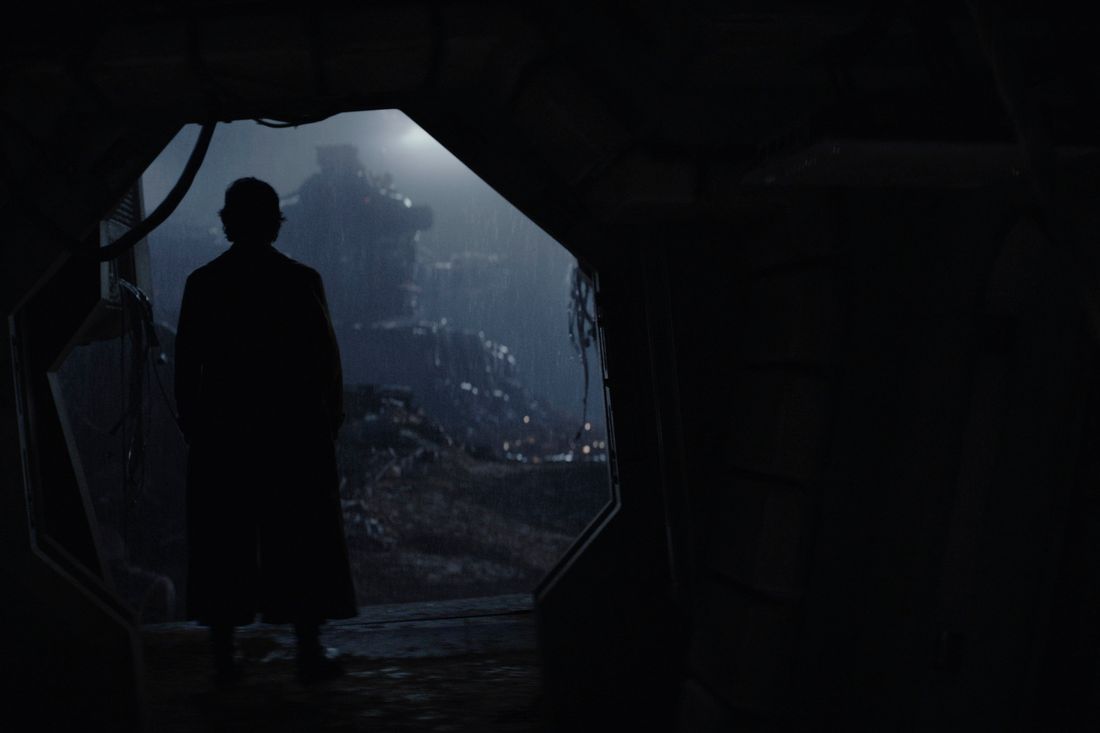
Spoilers ahead for all of Andor season one, including finale ‘Rix Road.’
It’s one of Star Wars’ most enduring images: A young Luke Skywalker looks out over the Tatooine dunes at the setting twin suns, yearning for a life larger than his own. There’s an elemental power to this picture, how it captures a youthful desire for adventure, meaning, everything. Of course, he gets exactly what he wants. Before long, young Skywalker is thrust into an adventure that takes him across the stars and far away from home, deep into an underdog rebellion’s struggle against a galactic empire. Much has already been written about Luke Skywalker and his relation to the monomythic Hero’s Journey, but it bears reiterating — there’s a reason for the lasting strength of this franchise.
It also bears reflection. I’m much older than when I first encountered what is now called A New Hope, having become a person who pays taxes and watches the world and has tasted some amount of salt. And at this age, I tend to find myself annoyed with how Luke’s desire to join the rebellion was originally driven by a wish for excitement as opposed to some sense of duty. Young Skywalker gazes longingly out at the horizon, pining for adventure, while all around him the people of Tatooine grind along under the yoke of the Empire. It’s not until Uncle Owen and Aunt Beru get torched by stormtroopers that the struggle becomes material to Luke, and even then, it’s still kind of personalized.
In the finale to Andor’s outstanding first season, which is essentially about an awakening to a broader struggle, Cassian Andor comes home to Ferrix. He arrives at the beginning of this story no longer the same, having gone through hell and back with his experience at the Narkina 5 Imperial labor camp. Ferrix, too, is no longer what it was. The place is now deeper under the heel of Imperial control as a direct and indirect result of Andor’s actions — as a consequence of him killing two Pre-Mor security guards, resulting in the explosive imbroglio with Syril, Mosk (“pockets of fomenting!”), & Co., as well as an outcome of the Empire’s systematic response to the Aldhani heist. Friends have been harmed, lives overturned. Bix is no longer whole, rendered brain-scrambled via Imperial torture. At great risk, Andor has returned for his adoptive mother Maarva’s funeral, a moving ritual in which her ashes are cast into brick and set into a wall; one life of meaning memorialized as part of a whole. By the time he hears her holographic posthumous speech, which sparks Ferrix’s unrest into a full-blown uprising, Andor was already touching the point of complete transformation into a revolutionary. (Listening to those podcast recordings of Karis Nemik’s manifesto helped.)
It’s enthralling to read Cassian’s story as a mirror to Luke Skywalker’s. Where Luke is introduced to us as a picture of boyish innocence, we first meet Andor as a rogue, unafraid to murder and scrabbling together a life of tiny resistances. He’s a man who treats the prospect of a greater good with indifference. “Alliance, sep, guerilla, Partisan Front … I think it’s all useless,” Andor tells Luthen Rael, the shadowy spymaster who turns him into an asset. “Better to spit in their food and steal their trinkets,” Luthen provokes. “It’s better to live,” he replies. At this point, Andor’s goals are mostly interior to himself and the people within his circle: His life appears motivated by the pursuit of survival and the mystery of his sister, from whom he was separated as a child. In other words, Andor’s struggles are purely personal.
You can’t really blame the guy: Life in an intractably bad political system grinds you down, there’s only so much energy to give before it perhaps makes more sense just to focus on your own private world. Before long, though, Andor finds himself thrust deep into events far larger than himself, swept up in a slow-motion collision between a latter-stage Imperial bureaucracy and a revolutionary plot that will ultimately change him into becoming the kind of person he will be in Rogue One: a person who would give up his soul, and eventually his life, for the greater good. What’s so fascinating about Andor is how the bones of its Hero’s Journey — call to adventure, crossing the threshold, the road back, yadda yadda — essentially amounts to the story of an individual who is radicalized into rebellion.
One could certainly argue that Skywalker goes through a broadly similar transformation over the course of A New Hope and through Return of the Jedi. The young moisture farmer learns to become a rebel pilot, a Jedi, and a warrior for good by virtue of what makes him special, later grappling with what it means if the evil you’re fighting is a part of you. But owing to the pulp-adventure shape of the original Star Wars trilogy, those stories only ever revolve around Luke’s private universe. He fights for good, yes, but mostly he fights for his friends, his family, and eventually, his religion. Luke’s adventures bounce him across planets, from Tatooine to Bespin to Endor, but rarely do the original films imagine him in relation to the universe he traverses. Meanwhile, Cassian emerges throughout the season as a relatively ordinary person actively shaped into a hero by the many worlds he visits.
It is perhaps more possible to realize a story of Andor’s scope through serialized television as opposed to a series of films — after all, a 12-episode season gives you a lot of room to world-build and weave in complexity. But I bring up Cassian’s story as a contrast to Luke’s not as a means to argue one’s superiority over the other. That’s boring. Rather, the point is to emphasize possibility. Star Wars is as pervasive a cultural object as there is, and Andor illustrates how new rabbit holes and new life can still be found within such an old text.
I’m far from the first person to sing the show’s praises. (Shout-out to my colleague Roxana Hadadi with the pitch of the century: Michael Clayton in space.) The remarkableness of Andor encompasses many aspects of the production: the utter confidence of its storytelling, led by Tony Gilroy; the richness of its political ideas, going far beyond what Star Wars has ever done in its films and prior live-action television output; Nicholas Brittell’s score, full of bangers Niamosi and otherwise; Luke Hull’s gorgeously considered production design, from the wall of gloves on Ferrix to the smudges on the windows of Eedy Karn’s middle-class Coruscant apartment; the glorious, glorious dialogue. (Luthen’s speech at the end of “One Way Out” is not something I’ll be forgetting anytime soon.) All these things put together would be genuine miracles on any TV show, let alone within the context of a modern Disney entertainment franchise fundamentally constructed to sell streaming subscriptions, merch, and amusement-park tickets.
But what specifically kicked my ass is just how seriously Tony Gilroy and company took the world of Star Wars, fully considering it as a tangible universe of actual people and material consequence. This is done primarily through the asking of simple questions about how this fictional reality works and how people exist within it, then enthusiastically tumbling down those rabbit holes. The end result is a vivid sense of verisimilitude, and boy, does Andor go so fucking hard in that regard. The Aldhani heist doesn’t target some galaxy-ending MacGuffin, but literal Imperial payroll. An empire doesn’t just rule with an iron fist, but also with COMSTAT-esque detention quotas. A prison break isn’t just an action set piece, but the logical end point of a process of which we’re shown almost every step.
The attention to detail in Andor is Better Call Saul–esque: Here’s a show that intimately knows the ways in which a sense of accounting leads to realism, and how that can produce a potent sense of narrative cause and effect. Now, as any evocation of Better Call Saul would suggest, I can see how some Star Wars fans and viewers could find Andor slow despite its craftsmanship, and how the series may well be among the least-watched Lucasfilm projects in years. We’ll see about the ultimate uptake; after all, the thing about streaming shows is they can theoretically provide value well beyond the release run, and it will be interesting to see how Disney’s move to air the first two episodes on ABC might change things up. In any case, Andor-heads won’t have to worry much, as the show was designed to unfold over two 12-episode seasons, and production just started on the second.
But it’s still reasonable for those of us who enjoy this take on Star Wars to sweat a bit. Andor is a breath of fresh air, a model of what we should want more of from our contemporary entertainment universe governed by competing all-consuming franchises — not necessarily something more “gritty and grounded,” just … different. There was a time, not long ago, where there existed the possibility of Star Wars as a narrative playground, one where more and different kinds of stories could be told, more characters could be foregrounded, more genres and filmmaking styles could be integrated into the core text. That hasn’t really come to pass, and with the continuous scuttling of previously announced projects, along with the indefinite shelving of Patty Jenkins’s theoretical Rogue Squadron movie, the fate of that particular vision for the franchise now seems tenuous.
So we’ve mostly been left with more of the same. Star Wars, particularly the films, trends toward planet-hopping high space opera, and has generally exhibited an excessive interest in the tribulations and fates of certain special people: the Skywalkers, yes, but also Jedis, Siths, Force users writ-large, legendary bounty hunters, little green chosen ones. Which is perfectly fine, it’s what has long been enjoyable about the franchise. But modern Star Wars has come to lean on this mode like a crutch, inhibiting the possibility for organic evolution. This was never more so than in the wake of The Last Jedi, which pushed the franchise with possibility-expanding provocations like “What if the meaningful people in this universe weren’t only tied to the Skywalker saga?” and “What if we had to reckon with the consequences that come with the swashbuckling antics of flyboy pilots?” The resulting overcorrection, The Rise of Skywalker, was as much of a creative disaster as it was an existential one, suggesting a franchise that’s fast running out of ideas. (The other live-action TV show from the Star Wars universe that came out this year, Obi-Wan Kenobi, while apparently widely watched, didn’t do much to dispel the notion.)
Andor feels like the project that splits the difference. Despite its contrast with the films, the show doesn’t necessarily carve itself out as entirely separate from the existing Star Wars tapestry. As the prequel to Rogue One, itself the prequel to A New Hope, we go into the series broadly knowing that the events ultimately lead to the mainline series’ attack on the Death Star, and the show operates as an effort to find new storytelling possibilities from the margins of the established mythos. This may well prove to not be enough. But even if Andor fails in being the Star Wars show that economically justifies a whole new artistic lane for the franchise, what it’s already given us is so radically interesting that you have to imagine it’s laying down some sort of foundation for future projects to come. “We need all the heroes we can get,” says Luthen to a wavering believer. In the world of Andor, to be a hero means a willingness to be a brick in the wall. Perhaps the same could be said of Andor itself.


